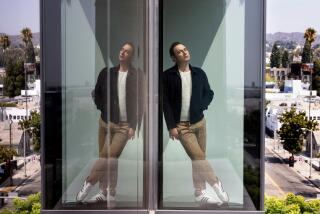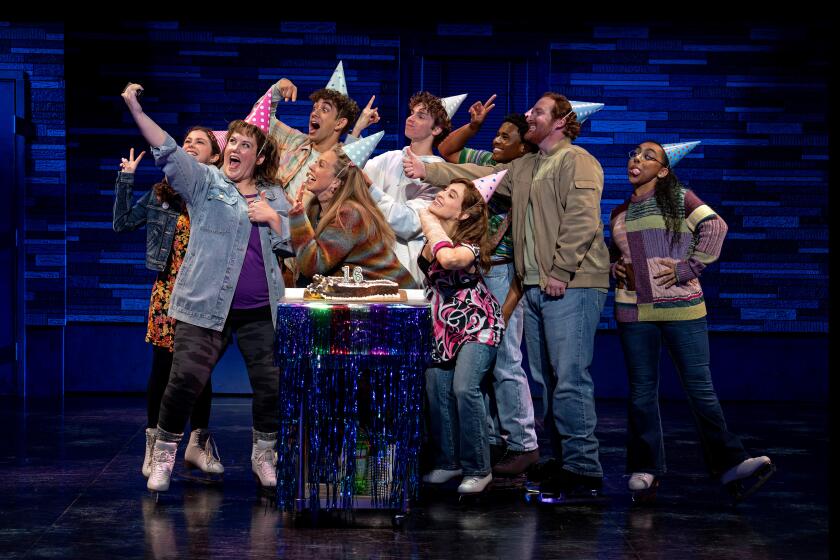Crossroads
Jennifer Steinkamp is an artist who collaborates with musicians to make light-and-sound installations of mind-boggling beauty. Currently featured at the Fremont Street Experience in Las Vegas, her largest computer-generated video projection is 5 stories high and 3 blocks long. Other works can be seen in the rotunda at the Corcoran Gallery of Art in Washington, D.C.; at the Los Angeles County Museum of Art’s children’s exhibition “Made in California: Now” exhibition; and above the main entrance to Staples Center (whenever an event takes place inside). Jeanie Weiffenbach is director of the Donald R. and Joan F. Beall Center for Art and Technology at UC Irvine, which opened in October. They met to discuss digital technology’s impact on the visual arts.
David Pagel: Does the Beall Center for Art and Technology collect art?
Jeanie Weiffenbach: No. The University Art Gallery has a collection, and the Beall Center has a research mission. We are also developing a residency component.
Jennifer Steinkamp: I’m just curious: Why wouldn’t that involve collecting?
Weiffenbach: Well, maybe it’s just at the moment that it doesn’t involve collecting. You have to define what it is that you would collect. And what form the collection would take. Would you collect the accouterments of an installation--the speakers and computer? Or just the disks? When you dismantle the chip control, there’s virtually nothing there except the kiosks, which are useless without the CD.
Pagel: So you are primarily a research-and-development institution?
Weiffenbach: Our mission is to encourage the relationship between art and technology through collaboration between artists and people in various technologies, such as engineering, computer sciences, the biological sciences, whatever. It is also to encourage the development of new art forms, and to educate and enlighten the public by exhibiting these new art forms.
Pagel: Jennifer, when you combine art and technology in your work, how do you weigh the two components?
Steinkamp: Well, for me the technology is not the main point. It’s more like it’s just there. As new tools are invented, I get really excited and want to see what they can do. But as for my artwork, that has evolved much more slowly. To get to where I am now has been a gradual progression.
Weiffenbach: Were you interested in the computer before you started using it in your work?
Steinkamp: When I first was introduced to the computer for making art, I saw it as something that, wow, could make these images I’ve never seen before. That really intrigued me. When I saw those things I just knew that I had to do something with them. I guess I’ve never been so interested in cutting-edge technology. I’m interested in using what’s available, what I can deal with. I don’t really want my art to be about the technology. As an artist working with technology, you’ve got to watch out that the technology doesn’t become the emphasis--to ensure that the art is what’s being seen. Computer programs are just tools I use.
Pagel: Standard, off-the-shelf software?
Steinkamp: It’s not so off-the-shelf. It’s pretty specialized. It’s what people use in the entertainment industry, for special effects. This software gets me deeper and deeper into what I do. It’s sort of like when you first run [the software program Adobe] Photoshop: It grows on you, and you realize how much potential is in it. What I use is light-years beyond that.
Pagel: Jeanie, are you interested in technology per se?
Weiffenbach: Well, I have to say I come at it from the art angle. I do not think of myself as an expert. I’m still getting oriented. But I have been working with experimental art in all its forms for all of my adult life. I’m always on the lookout for things that challenge the status quo.
Pagel: And digital technology does?
Weiffenbach: Yes. There’s a lot of amazing work going on.
Pagel: It seems that there are more books--more theorizing--about digital art than there is digital art. Are we putting the cart before the horse, or is this a misperception?
Weiffenbach: Maybe not. But there’s another side to it, a side that is not in the books, as far as I know. The cart isn’t getting put before the horse because there’s lots of work out there that has not been dealt with at all, much less dealt with as art. I don’t see many publications that are coming to terms with that: Digital media are not easily written about as art. Although this is a subject I try at all costs to avoid, it’s inescapable here. It is another leap that has to be taken. Until digital works are seen in an art context they will not be assessed properly--that’s the biggest challenge. And no one knows how [or why] digital technology is art.
Pagel: How do current developments in digital media compare to the invention of photography and the moment when video cameras became readily accessible?
Steinkamp: Well, I think it’s similar in the amount of acceptance that digital art has had. Like early photography and early video, it has had to defend itself from the charge that it’s not art. Only very recently have people started to collect video art.
Pagel: And digital art has not yet reached that point?
Steinkamp: In general, people don’t know how to deal with it. The archiving issues are huge, but they can be dealt with. A bigger question is: How do you define digital art? Today, many artists work with Photoshop. Lots of painters are working on computers. To a certain extent, it’s an accepted part of the creative process. But other media and more advanced programming are not as widely accepted.
Pagel: Institutions seem to be springing up faster than ever before. How long was photography around before museums began to collect it? How long was Modern art around before the Museum of Modern Art was built? And how long has digital art existed before the Beall Center opened? Does this sort of instant institutionalization have anything to do with corporate sponsorship?
Steinkamp: Why would it be corporate?
Pagel: Because of the high cost of research and development.
Weiffenbach: At the center, there is not a direct relationship between artists and corporate sponsors. The institution raises the money and acts as the intermediary. As long as it’s not compromised, I don’t see artists being unduly influenced by corporate interests.
Pagel: What is digital art’s relationship to entertainment?
Steinkamp: Well, museum attendance is at an all-time high. It would be sad, however, if these institutions were creating superficial shows merely to pack the crowds in. I try to create work that’s accessible on many levels. Art is about communication, so you have to choose your audience. Different artists communicate with different audiences. Some art is really funny. It engages you on one level and then brings you to a place that’s deeper and more thought-provoking.
Pagel: Do computer games work this way?
Weiffenbach: They may. There’s no stopping people who just want to be entertained. But there’s more to it than that. I am interested in games because they reintroduce play and pleasure to art. People have been just dying for that. Another project I’m working on is with the Center for Land Use Interpretation. I’ve commissioned their first digital piece.
Pagel: Yes, but at this point don’t the layers of mediation begin to get a little thick? I mean, a viewer goes to the Beall Center for Art and Technology and is presented with an exhibit by the Center for Land Use Interpretation. Does it really take two centers to mount one show?
Weiffenbach: Well, the Center for Land Use Interpretation has created an archive filled with information that they present in a very subtle way.
Pagel: But the people who work there are not artists.
Weiffenbach: I think they are. I really do think they are.
Pagel: Then aren’t the people who work at the Beall Center also artists?
Weiffenbach: Well, maybe I’m not so worried about that definition. If we’re doing something interesting, something that bridges certain gaps or poses certain questions--that seems to be the main challenge. And if people come to that, worrying about whether they know what is art or not, it’s my job to keep them from worrying about it, in a way, to lead them into the experience.
About This Series
Calendar asked three pairs of arts figures to discuss issues confronting the creators, consumers and purveyors of entertainment and the arts. The topics:
Monday: Is free speech being abused in popular culture?
Tuesday: Is L.A.’s diversity creating culture--or a cultural divide?
Today: How will digital technology affect the visual arts?
More to Read
The biggest entertainment stories
Get our big stories about Hollywood, film, television, music, arts, culture and more right in your inbox as soon as they publish.
You may occasionally receive promotional content from the Los Angeles Times.










